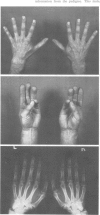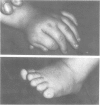Abstract
Triphalangeal thumb (TPT), a long, finger-like thumb with three phalanges instead of two, is regarded as a subtype of preaxial polydactyly. It can occur as a sporadic disorder, but is more often seen as a dominant familial trait. We describe four white Dutch families in which triphalangeal thumb has variable expression and is sometimes associated with preaxial extra rays, rudimentary postaxial polydactyly, cutaneous syndactyly of the hands, and, rarely, postaxial polydactyly and syndactyly of the feet. A comparison with similar familial conditions reported during the past 10 years is provided. The potential significance of linkage and molecular genetic analysis for better insight into the pathogenesis of complex hand malformations is discussed.
Full text
PDF





Images in this article
Selected References
These references are in PubMed. This may not be the complete list of references from this article.
- Graham J. M., Jr, Brown F. E., Hall B. D. Thumb polydactyly as a part of the range of genetic expression for thenar hypoplasia. Clin Pediatr (Phila) 1987 Mar;26(3):142–148. doi: 10.1177/000992288702600308. [DOI] [PubMed] [Google Scholar]
- IVY R. H. Congenital anomalies; as recorded on birth certificates in the Division of Vital Statistics of the Pennsylvania Department of Health, for the period 1951-1955, inclusive. Plast Reconstr Surg (1946) 1957 Nov;20(5):400–411. [PubMed] [Google Scholar]
- Merlob P., Grunebaum M., Reisner S. H. Familial opposable triphalangeal thumbs associated with duplication of the big toes. J Med Genet. 1985 Feb;22(1):78–80. doi: 10.1136/jmg.22.1.78. [DOI] [PMC free article] [PubMed] [Google Scholar]
- Miura T., Nakamura R., Horii E., Sano H. Three cases of syndactyly, polydactyly, and hypoplastic triphalangeal thumb: (Haas's malformation). J Hand Surg Am. 1990 May;15(3):445–449. doi: 10.1016/0363-5023(90)90057-x. [DOI] [PubMed] [Google Scholar]
- Nakamura J., Kanahara K., Endo Y. Familial congenital hypoplasia of the thumb--report on a family. J Hand Surg Br. 1984 Jun;9(2):145–148. [PubMed] [Google Scholar]
- Nicolai J. P., Hamel B. C. A family with complex bilateral polysyndacty. J Hand Surg Am. 1988 May;13(3):405–407. doi: 10.1016/s0363-5023(88)80019-4. [DOI] [PubMed] [Google Scholar]
- Qazi Q., Kassner E. G. Triphalangeal thumb. J Med Genet. 1988 Aug;25(8):505–520. doi: 10.1136/jmg.25.8.505. [DOI] [PMC free article] [PubMed] [Google Scholar]
- Radhakrishna U., Multani A. S., Solanki J. V., Shah V. C., Chinoy N. J. Polydactyly: a study of a five generation Indian family. J Med Genet. 1993 Apr;30(4):296–299. doi: 10.1136/jmg.30.4.296. [DOI] [PMC free article] [PubMed] [Google Scholar]
- SESGIN M. Z., STARK R. B. The incidence of congenital defects. Plast Reconstr Surg Transplant Bull. 1961 Mar;27:261–267. doi: 10.1097/00006534-196103000-00003. [DOI] [PubMed] [Google Scholar]
- Warm A., Di Pietro C., D'Agrosa F., Cambiè M., Gaboardi F. Non-opposable triphalangeal thumb in an Italian family. J Med Genet. 1988 May;25(5):337–339. doi: 10.1136/jmg.25.5.337. [DOI] [PMC free article] [PubMed] [Google Scholar]
- Wassel H. D. The results of surgery for polydactyly of the thumb. A review. Clin Orthop Relat Res. 1969 May-Jun;64:175–193. [PubMed] [Google Scholar]
- Wood V. E. Treatment of the triphalangeal thumb. Clin Orthop Relat Res. 1976 Oct;(120):188–200. [PubMed] [Google Scholar]





